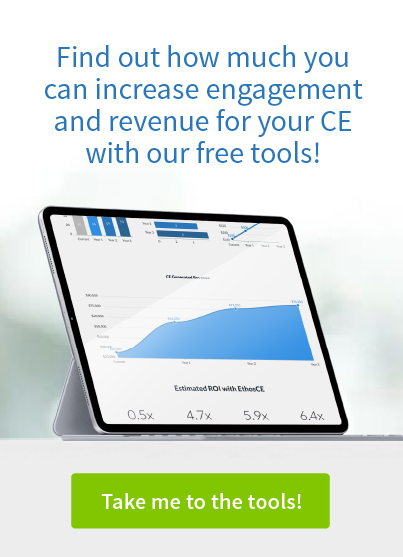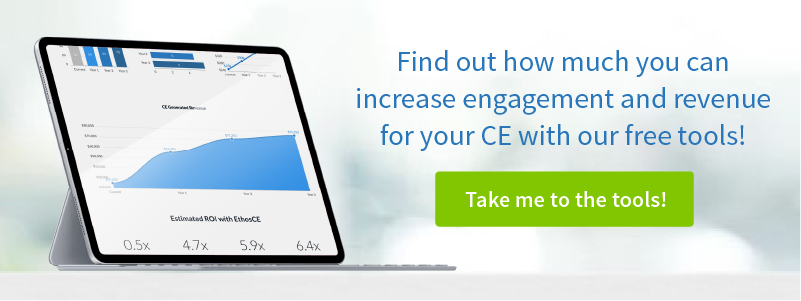How a Low Cost LMS for CME Costs You More in the Long Run
It stands to reason that focusing on your bottom line is always a smart choice. When it comes to software, however, the difference is that a low cost LMS platform rarely offers the kind of value that you need to support your organization’s goals. That’s because unlike a great deal from a retailer, the value offered by software is contained in its features: if it isn’t there on the day your program launches, then you’ll end up paying for it many times over as your program grows. In this post, we’ll look at some steps to get the most value for your budget while making sure you have the features that your program needs to ensure success.
Step One: Don’t Accept Unwanted “Features” for a Lower Price
Your LMS is the engine of your program’s success. From user experience to data management, the quality of the software running your LMS will determine how quickly (and affordably) your organization can meet its CME objectives. Bargain LMS platforms often provide value that matches their low, low price. This often includes the following unwelcome features:
Poor User Experience
Complicated or limited user-facing navigation. When learners find it hard to navigate your platform upon first use it may impact their willingness to stay with their course when the content becomes challenging. Limit user frustration by using a platform that takes user experience design best practices into account.
Non-intuitive activity formats.
Non-intuitive means difficult to use for the average learner, making it hard for users who make common mistakes to return to their activities or recoup their progress. Activities that present functional challenges make it difficult for learners to become fully engaged with their educational experiences, increasing the likelihood that they will leave the course upon finding a more user friendly alternative.
Limited Administrative Tools
Time-consuming, repetitive administrative tasks usually cannot be automated. From emails to transcript importing, low cost LMS platforms rarely provide task automation tools that allow your staff to focus on member services more than data entry and verification. When your team must divide most of their time between low-level (yet critical) administrative tasks, program growth can become problematic and drive up costs as you pay for new features to balance task management.
With a low cost LMS, you will have to compensate for your platform’s failures by taxing human resources, purchasing add-on features, or searching for a third-party solution.
Critical consumer touch points (like order fulfillment) must be managed manually. When you need it most, low cost LMS platforms rarely provide the kind of reliable, automated support that you need when managing key consumer platform interactions like course registration and order processing. One of the most common reasons that consumers abandon online carts is a payment problem. If your members find numerous reasons to doubt your commitment to providing a high quality user experience because of a bargain LMS, then you may be inadvertently compromising your organization’s capacity to reach its CME goals.
Low or No Support for Learners or Your Organization
A limited tech support option or no support at all. As surprising as it is, many low cost LMS platforms offer little or no support to new clients. Once you’ve paid for your platform you are on your own. That means no on-boarding process, no training, no helpful human ready to listen when you have a question that can’t be easily answered from the manual. Some low cost LMS services do offer initial support, but then charge you after a limited number of questions. Needless to say, a poorly designed LMS actually earns money for some of these companies, since the more problematic the platform is, the more you will have to call (and pay) to ask for help.
A confusing or non-existent self-help structure. When platform users have a hard time solving a low-complexity problem on their own, it makes it more likely that they will call your support line, and by extension, add to their frustration. Frustrated consumers are rarely loyal ones, so diminish the risk of losing members by purchasing an LMS that provides extensive on-call support and a user-friendly self-help structure.
Poor or Non-Existent Advanced Data Management Capabilities
Since advanced data management capabilities are usually only provided by enterprise-grade platforms, a low cost LMS will most likely require you to:
- Collect and program and learner data manually and enter it into a spreadsheet
- Create data segments for analysis by hand
- Update changes to key data sets manually
- Develop your own templates for data reports and notifications
An Inflexible Curriculum Structure
For most low cost LMS platforms, you will have to purchase the right to:
- Add third-party or native video
- Use any form of motion graphics
- Integrate a webinar
- Add live streams
- Allow check-ins at live events
- Use downloadable materials
- Add sound or video to assessments
- Automate individualized learner feedback before, during, and after assessments or at key points along the course timeline.
With a low cost LMS, you will need to purchase “add on” features to get the basic functions that you need for your platform to support program growth, or you will have to work with a web development firm. If your organization’s goal is to get the most out of your budget, then a low-cost LMS is a bargain that you can’t afford.
A cheap LMS will simply add more duties to your plate as your program becomes more successful without providing any solutions for increasing productivity.
Step Two: Know What Your Organization Needs to Protect Your Bottom Line
Regardless of the size of your organization or your program, here are some basic features that you will need to ensure that you are getting the most value out of your budget:
- Full control of your data, including automated data collection, warehousing, and management
- Automation of time-consuming, repetitive administrative tasks like bulk user transcript import and registration processing
- The ability to update your team with customized reports, data visualizations, and automated alerts with a few clicks
- A flexible curriculum that allows you to respond to the needs of your learners with innovative content that can be integrated to existing activities easily.
When selecting your LMS, here are five important facts to keep in mind:
- A low-cost LMS may cost you more than you anticipated in the long run, even if you are getting a “great” bargain now.
- As your program grows, so will your need for a solid, multi-featured platform that can accommodate change.
- If the value hidden within your data goes unused because your LMS cannot provide data management features then your platform is costing you potential profit.
- A cheap LMS does not offer the end-to-end support that your program will need to meet the challenges of a competitive market.
- Task automation through an enterprise-grade LMS allows you to leave time-intensive, repetitive tasks to your LMS platform.
EthosCE Analytics, our user-friendly data management and analytics suite, it is simple to get a 360-degree view of your program’s progress and then drill down to view in-depth the educational outcomes of students course-by-course or individually.
EthosCE, an enterprise-grade platform provides features and services designed for a growing enterprise, giving you control over your data and helping you get the most out of human resources through task automation. From launch, EthosCE offers the value that your program needs to grow while helping you guard your bottom line. Learn how enterprise-grade features can transform your CME program.
If you would like to learn more about how to find a low-cost LMS for your CME data, feel free to reach out to EthosCE today for a 1-on-1 walkthrough with one of our solution specialists!
 We're now part of the Cadmium product suite! Learn more
We're now part of the Cadmium product suite! Learn more 


